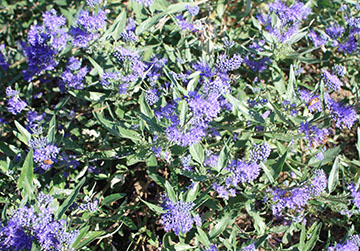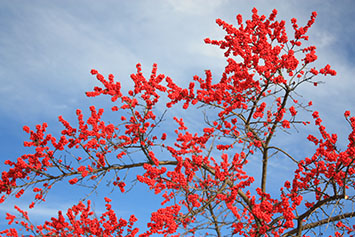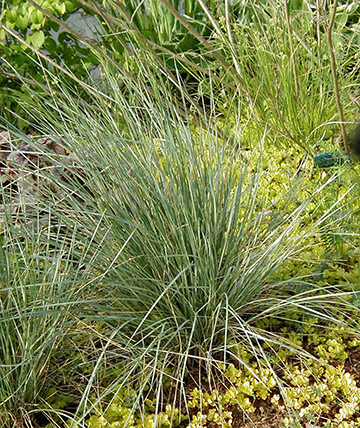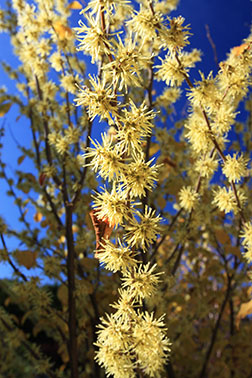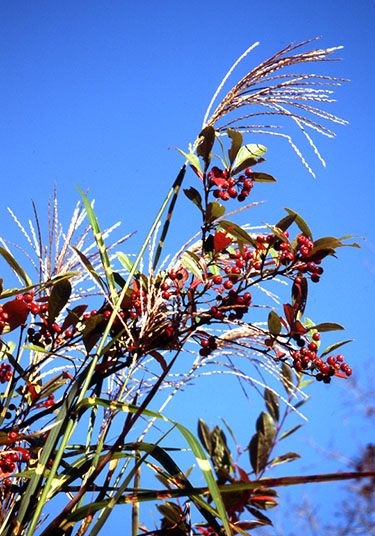Autumn 2019 Newsletter
Fall is the perfect time for planting. Temperatures are a bit cooler, yet the soil is still warm. Fall planting allows perennials, bulbs, trees and shrubs to get a head start for spring. The cooler weather, and reduced humidity, also makes it more pleasant experience for the gardener. It is a terrific time to prepare the garden for winter and the spring to follow, while adding stunning fall color to the landscape.
Group plants in swaths of color to create a strong visual impact. Use asters and hardy chrysanthemums, the stars of the late season. These reliable perennials grow all summer and then burst into blooms of blue, purple, pink and white in the fall. They also have a pleasant aroma, and support the ecosystem by providing food and habitat for pollinators. Or mass rudbeckias, sedums, alliums or golderods. Add movement with tall daylilies, such as ‘Challenger’, Helianthus ‘Salicifolia’, Rudbeckia “Henry Eilers’ or Ornamental Grasses. Contrast textures by placing plants and garden elements with bold, structural forms next to lighter, airy forms to create more interest. Sedum ‘Autumn Joy’ will contrast with Blue Oat Grass (Helictotrichon sempervirens). Hardy Cyclamen bloom in colors of pink and white in autumn and hold their attractive mottled leaves through the winter.
Plant trees and shrubs. Conditions are ideal to help them establish themselves for spring growth. Don’t forget the autumn blooming shrubs and trees. Lespedeza thunbergia doesn’t even begin to make a showing until September. This six foot tall shrubs is covered in masses of deep pink ('Gilbraltor' or 'Spring Grove') or white flowers ('Avalanche') into October. Indigofera ambylantha blooms from June through to frost with delicate pink clusters. The branches of the Blue Mist Shrub, (Caryopteris x clandonensis) are adorned with blue flowers through August and September. A wonderful tree for fall bloom in Heptacodium miconioides, the seven son flower. It is covered in white flowers in September. When the petals drop, the pink calyxes provide color through the fall. Showcase autumn foliage to make a big impact. Add at least one tree chosen for its fall foliage. Acer griseum, the paperbark maple, turns a spectacular orange in autumn. bloom is Heptacodium miconioides. Our native Witch hazels, Hamamelis virginiana, blooms in the fall, and Hamamelis vernalis, blooms in winter. Mahonia bealei, also blooms in winter, while Lindera angustifolia, holds its leaves through the winter.
The end of the season is also a great time to prepare for next spring. Divide and transplant perennials in the fall. As their metabolism slows, it is much less disruptive than spring planting. Then plant flowering bulbs to add to the anticipation of the spring ahead. Visit your local garden center or check out one of our favorite bulb sources. Brent and Becky's Bulbs in Gloucester Virginia for most bulbs and for the unusual try Daffodils and More in Dalton, Massachusetts. Dave Burdick grows the lovely Colchicums (Autumn Crocus) that brighten our gardens.
Replenish mulch layers in the garden. Around perennials, mulch should be one to two inches. Around shrubs, mulch should be 2 to 3 inches, and around trees the mulch should be about 4 inches.. Be sure to spread mulch around trees in a flat layer and keep the mulch away from the trunk of the trees. Use all those fallen leaves, either chopped or whole, as a natural mulch over your new plantings.
Create a spot to rest in the garden. A well-placed bench, pair of chairs or outdoor lounge can encourage you to slow down and appreciate the passing of the season. Look for places where you would naturally be inclined to relax, such as an area that catches the afternoon sun or a place against a wall, where you can view and admire the garden. Then sit down and take a moment to enjoy your hard work.
Irrigate, Irrigate Irrigate. The generous rainfall of the late spring, reduced the need for watering in the early season. However, July, August and September was very droughty. The recent rain will help, although in Rehoboth we measured just more than an inch. Deep watering, for established plants, should be necessary once a week, even during very dry periods. If we don't get a full inch of rain in a week, then plan to supplement. Newly planted perennials and shrubs will need more frequent watering. Irrigate two or three times a week, while they are getting established. Continue to water any new plantings through October to promote a healthy root system.
The gardens at Tranquil Lake Nursery are known for their plant combinations that provide interest from spring past frost. Visit the nursery soon to view our late season splendor. Below are some of the late season beauties you will meet.
|
|
Blue Mist Shrub (Caryopteris) blooms through the late summer and autumn. 'Worcester Gold' also offers golden foliage. |
Winterberry Holly (Ilex verticillata) will drop its leaves in late fall and hold berries through the winter, or until the birds have eaten them all.
|
|
|
Blue Oat Grass (Helictotrichon sempervirens) has narrow blue leaves that stand up through the winter. |
Hamamelis virginiana, our native witch hazel, drops its leaves in the fall soon after the blooms appear. We have selected a witch hazel with larger flowers, that we call 'Wicked' |
|
|
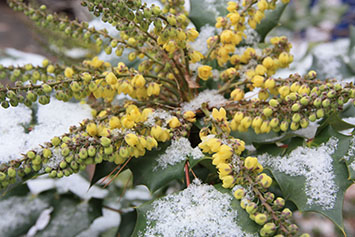 |
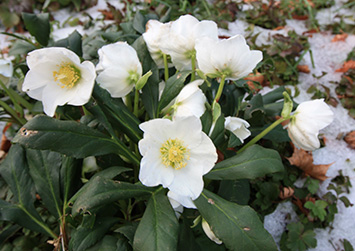 |
Mahonia bealei (Leatherleaf Mahonia) sports evergreen foliages and flowers that bloom in February. |
Helleborus niger blooms in late winter and holds its foliage through the winter |
 |
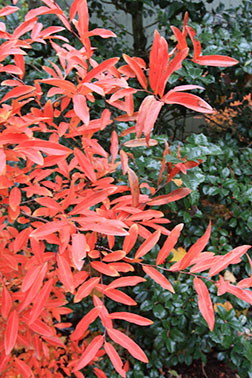 |
Hamamelis 'Shimamichi Red' is a japanese witch hazel than blooms in late winter |
Lindera angustifolia in fall color. This shrub will hold its leaves through the winter, droping them in late spring as the flowers appear. |
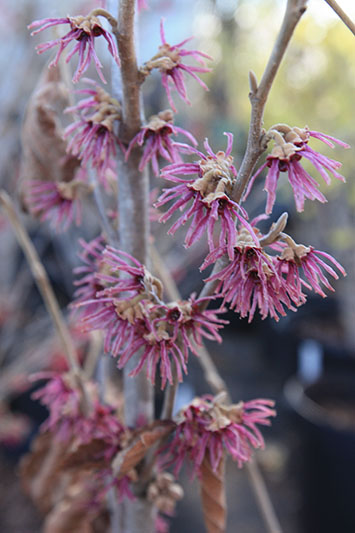 |
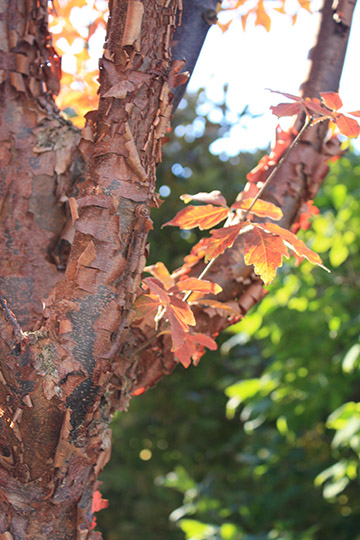 |
Hamamelis vernalis 'Amethyst' produces lovely amethyst purple flowers in late winter. We have grafted 'Amethyst' witch hazels in tree form. |
Paper Bark Maple (Acer griseum) has gorgeous autumn foliage and exfoliating bark. |
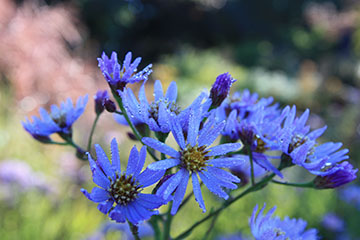 |
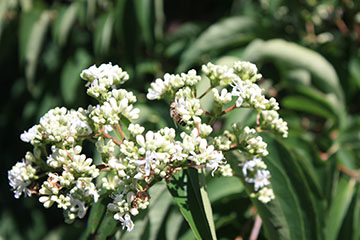 |
Aster tataricus starts blooming in late September on tall stems. |
Heptacodium miconioides (Seven Sons Flower) is a small tree that blooms with white flowers in September. |
|
|
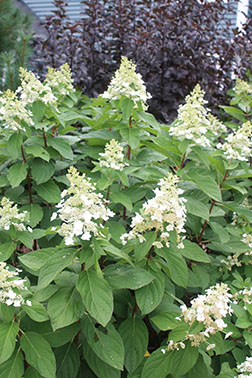 |
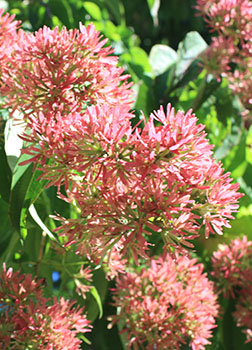 |
Hydrangea paniculata 'Tardiva' continues to hold its flowers through the fall. |
Heptacodium miconioides after the petals drop - pink calyxes through the fall |
. |
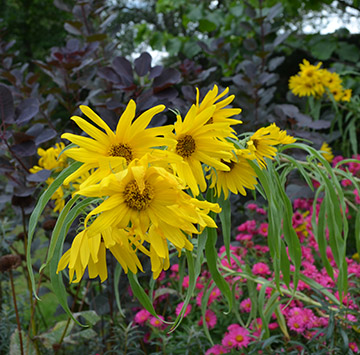 |
Rudbeckia 'Goldsturm' and 'Henry Eilers' |
Helianthus 'Salicifolia', Aster 'Alma Potschke' and Cotinus 'Royal Purple' |
|
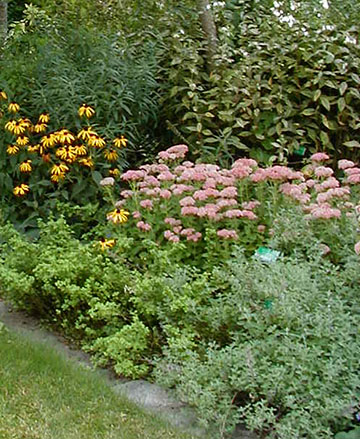 |
Chokeberry (Aronia arbutifolia) will hold its fruits through the winter. |
A fall border of sedum, black eyed susans and catmint. |

